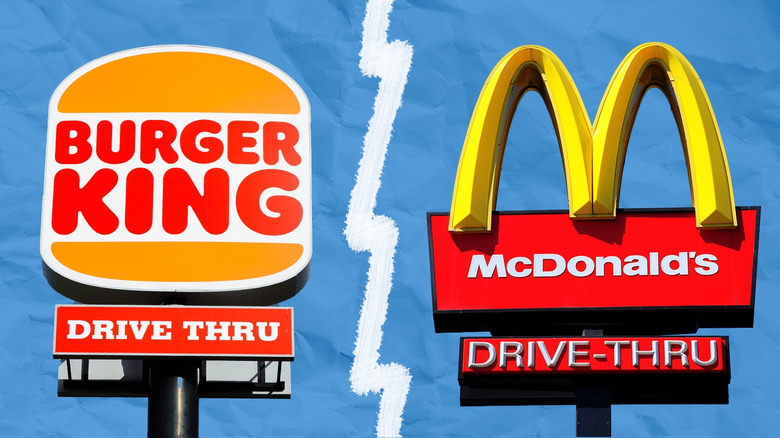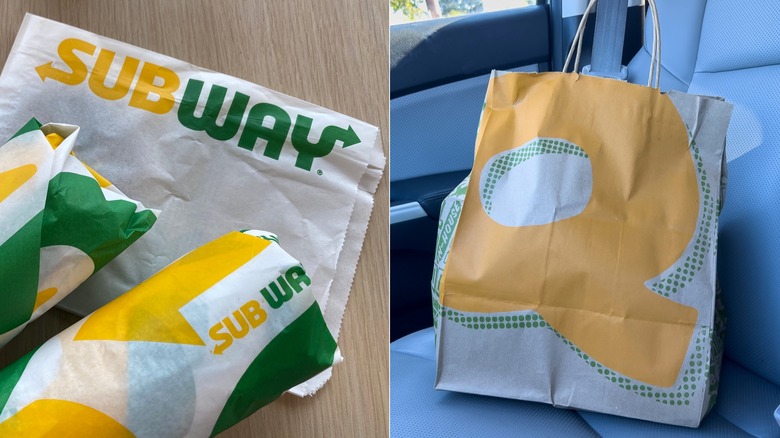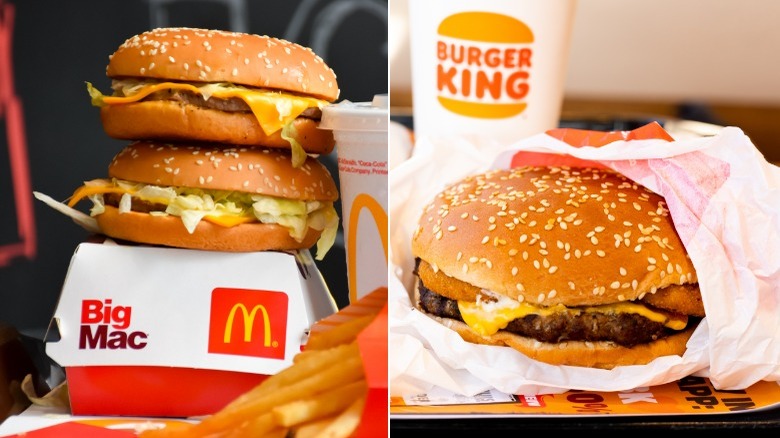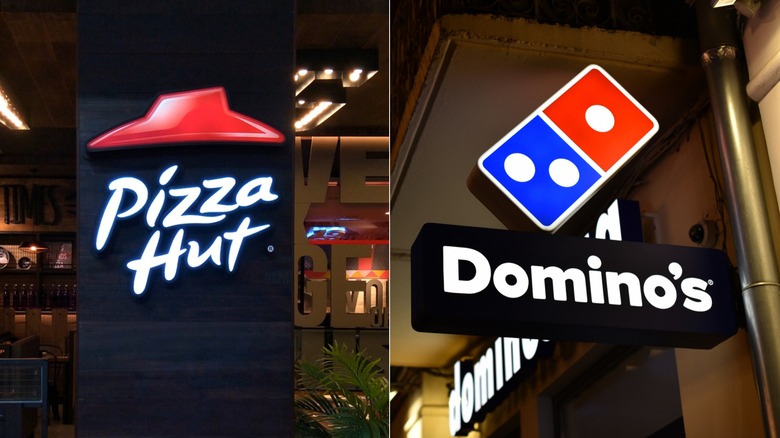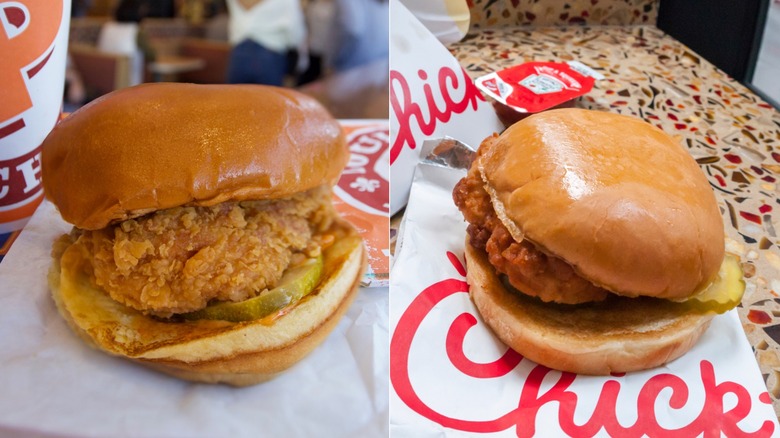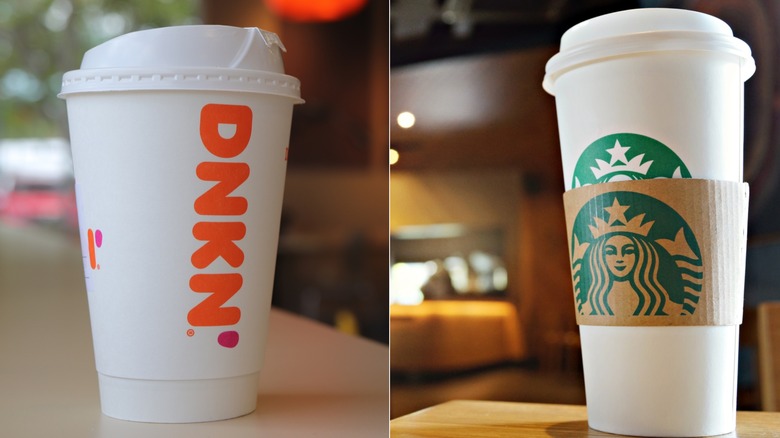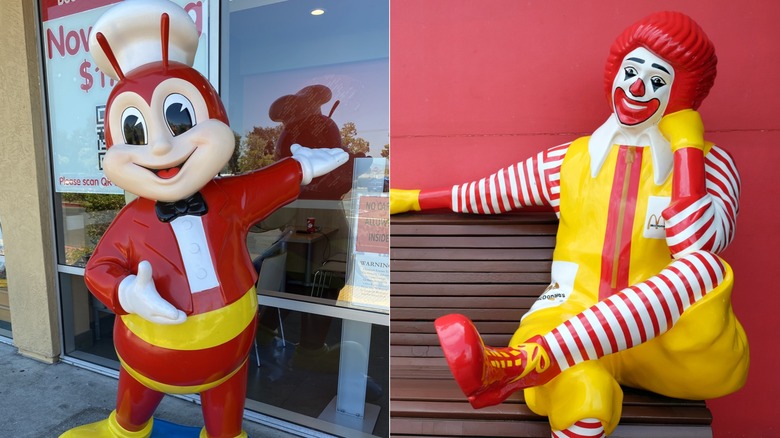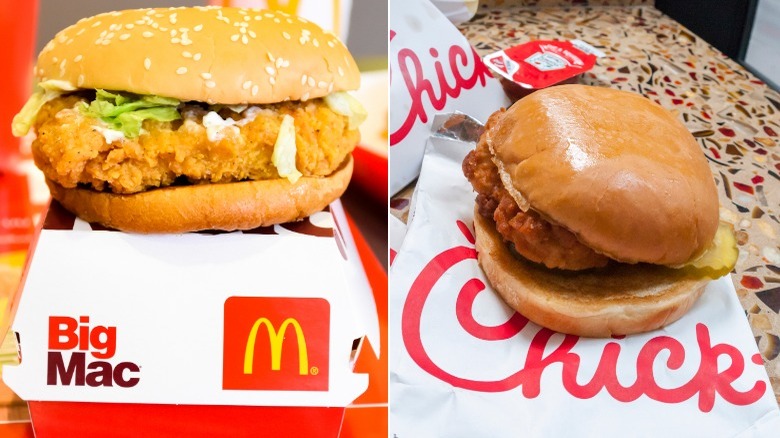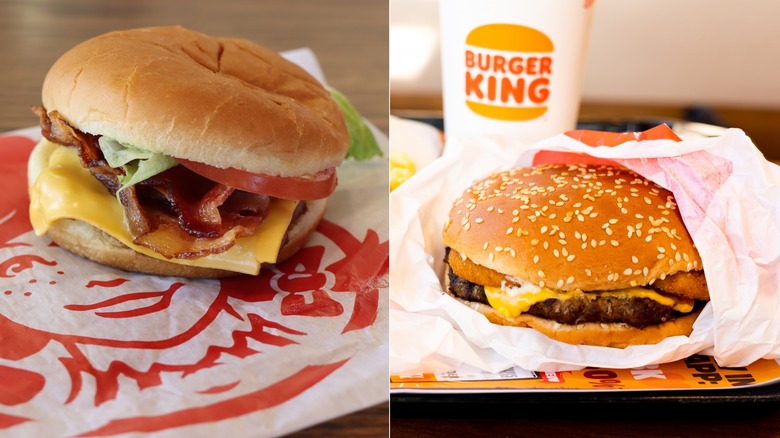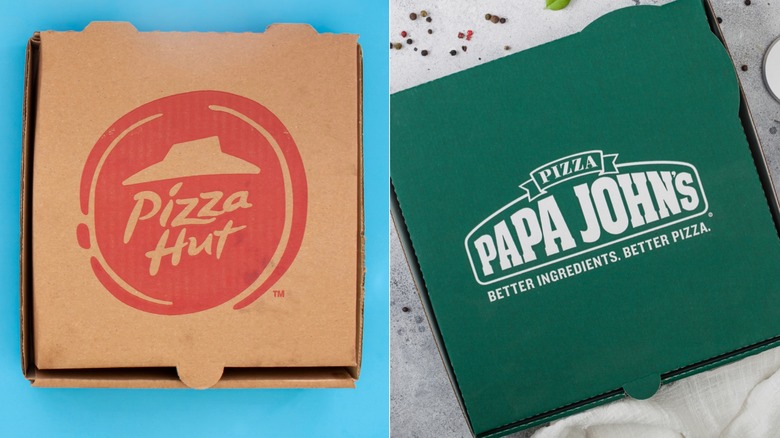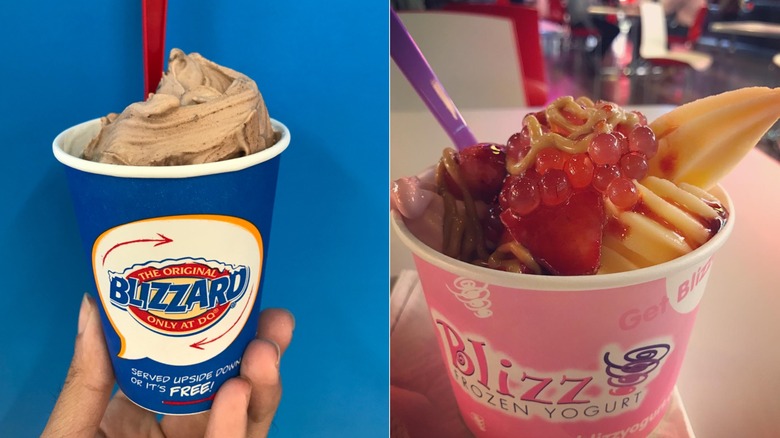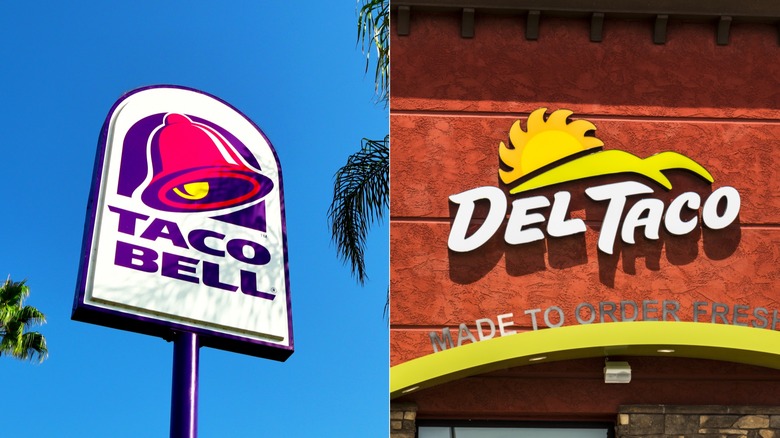Fast Food Rivalries That Got Heated
Fast food is big business. The U.S. fast food industry was forecast to bring in $331.41 billion in 2022 and over 100 rival chains are competing for a bigger piece of that pie. Sometimes, they'll try poaching customers by offering new products or promotional offers. At other times, they go straight for the throat with marketing campaigns that poke fun at or malign the competition. Sometimes, however, those rivalries go wrong. Companies might end up in embarrassing court battles that cost millions. The conflict might also trickle down to individual franchises as owners impulsively take matters into their own hands.
When handled well, feuds are a fantastic marketing strategy. Companies may choose to fan the flames of rivalry to keep customers loyal to their brand. This is also a tactic used by smaller companies in the hopes that consumers will place them in the same league as industry leaders. Finally, rivalries get people's attention and that means publicity without having to pay for it, like a ridiculous Twitter debate about chicken sandwiches that ends up in mainstream news sources. That potentially gets readers curious enough to jump in their cars and try some of the debated food.
Whether or not these food fights between quick-service chains are an intentional grab for attention or a natural consequence of competition, they've generated some surprising situations. Here are some of the fast food rivalries that got seriously heated.
Subway vs. Quiznos
Subway and Quiznos might have once had a mutually beneficial rivalry. Both chains were working to expand the sandwich sector and draw people away from burgers while benefiting from each others' advertising. But this so-called "healthy rivalry" was not to last.
In 2008, the two companies found themselves locked in a legal battle. In 2006, Quiznos debuted an advertising campaign that showed people choosing its meatier sandwiches over Subway's. Then, the chain sponsored a contest asking people to make videos showing the superiority of Quiznos's sandwiches. Quiznos awarded $10,000 to a clip that showed sandwich-shaped derby cars racing down a hill. A plain-looking Subway car topples over when the Quiznos car shoots smoke at it.
Subway took legal action. The resulting settlement changed the way companies could ask for user-made content — it would no longer be legal to encourage people to create media disparaging competitors. Quiznos's negative marketing campaign seemed to shoo customers away. This may have been the beginning of the end. In 2007, Quiznos had 4,640 locations but has suffered steady declines ever since. As of April 2023, there were only 154 Quiznos restaurants open.
Burger King vs. McDonald's
On Halloween 2016, advertisers covered a New York City Burger King with white sheets, then spray painted golden arches and the McDonald's name on top. The result: a whole restaurant had put on a costume, disguising itself as its toughest competition. But why?
A year earlier, Burger King took out full-page ads seeking a one-day truce with McDonald's for Peace Day. It proposed creating a pop-up restaurant to serve McWhoppers in an Atlanta parking lot between the two restaurants. Both were light-hearted advertising gimmicks, but the rivalry has its roots in the fierce burger wars of the 1980s.
In 1982, Burger King advertised that its broiled burgers were superior to the fried ones at McDonald's and Wendy's. Wendy's and McDonald's sued Burger King. Burger King agreed to nix the commercials if the two competing chains would drop the charges. After all, the campaign had already helped Burger King's sales rise by 19% and its post-tax profits by 9%.
In the end, no amount of clever advertising has gotten Burger King to first place in the fast food business. Even the combined 2022 sales of the second and third-place burger chains don't come close to McDonald's of nearly $46 billion. There may be a rivalry, but the winner is clear.
Domino's vs. Pizza Hut
At first, Domino's and Pizza Hut were in different markets. Pizza Hut focused on sit-down clients while Domino's kept to take-out and delivery. But then the '80s brought home entertainment to the fore. People wanted to stay in and order out and pizza accounted for around 25% of all food deliveries in 1985. That gave Domino's an advantage, as Pizza Hut didn't deliver — until 1986. To compete with Domino's there-in-under-30 guarantee, Pizza Hut set up call centers to direct orders to the nearest location and organize delivery. The pressure was on.
It worked and Pizza Hut cemented its place at the top for years to come. Yet tireless work from rival Domino's meant the larger chain was always looking over its shoulder. Technological innovations in Domino's delivery fleet, a reworking of the pizza recipe in the 2000s, and fantastic advertising campaigns set this chain apart.
Then, in 2018, the unthinkable happened: Domino's came out on top, selling more pizza and generating higher profits than its rival for the first time. By the end of 2022, Domino's reported sales of around $8.6 billion while Pizza Hut trailed far behind with about $5.5 billion. The underdog had prevailed.
Popeyes vs. Chick-fil-A
Chick-fil-A's famous boneless, breaded chicken sandwich has been on its menu since 1967. Popeyes has always stuck to fried chicken, but in August 2019, it introduced a chicken sandwich. Shortly after Popeyes announced the new menu item, Chick-fil-A tweeted about its original chicken sandwich without mentioning the competition.
That was all Popeyes needed. It responded to Chick-fil-A's tweet and asked "...y'all good?". The internet blew up into a debate about which sandwich was better. Popeyes sold out in less than a month with supplies meant to last three. It also doubled its in-store traffic and sales grew by 10%.
Chick-fil-A, meanwhile, has always opted for a slow-growth business model and stands firm. This chicken sandwich war had almost no impact on its earnings. In 2018 the chain reported revenue of $3 billion, in 2019 $3.8 billion, and in 2020 $4.3 billion. On the other hand, this rivalry put Popeyes in the spotlight and it's now the third-largest quick-service chicken chain.
Dunkin' vs. Starbucks
When it comes to Starbucks and Dunkin', it's clear which company has higher sales. Starbucks reported $24.3 billion in revenue in 2022, while Dunkin' brought in less than half that with $10.4 billion in sales. Perhaps because of that gap, Dunkin' rarely shies away from an opportunity to poke the beast.
It all started after Dunkin' introduced the Dunkaccino in 2000. Slowly but surely, the donut shop began posing a larger threat to Starbucks. This simmering conflict bubbled to the surface in 2006. In a Dunkin' commercial, singing coffee drinkers say they can't understand the menu at a shop, asking if it's in French or Italian. A narrator concludes that you can get delicious lattes at Dunkin' where "you order them in English, not Fritalian."
And in 2008, a research company contracted by Dunkin' gave 476 people brew made from Starbucks and Dunkin' coffee. When 54.2% said they preferred Dunkin's coffee, the company began to toot its own horn and even set up a website to mark the occasion. Starbucks never responded to Dunkin's prodding, though. It's hard to know if these advertising campaigns did the smaller coffee chain any good, either. In 2007, Dunkin' reported $5.3 billion in sales. In 2008, that number only grew to $5.5 billion.
McDonald's vs. Jollibee
Sometimes rivalries bring out the best in companies. They drive chains to improve service and quality to compete. That's what happened to Jollibee, the largest fast-food chain in the Philippines.
Jollibee started as an ice cream and burger shop in the 1970s. Then its owner, Tony Tan Caktiong, heard that McDonald's was planning to enter the Manila scene. He traveled to the U.S. to see what all the fuss was about and develop a defense strategy. He observed how McDonald's used a mascot, its employees gave out friendly smiles, and bright colors were used in-store to attract people. Soon, similar tactics appeared in Jollibee locations back home.
Caktiong grew his chain to five locations and added fries and fried chicken to the menu. When McDonald's finally opened its doors in the Philippines in the 1980s, it couldn't compete with Jollibee's established reputation or low prices. The giant has since found that it can't win against Jollibee on its home turf.
Chick-fil-A vs. McDonald's
Long before the fast food chicken wars began to really rage in 2019, McDonald's and Chick-fil-A were already in the fight. In 2006, McDonald's announced a new spicy chicken sandwich, a copy of Chick-fil-A's signature menu item. Today Chick-fil-A is the third-largest restaurant chain based on sales. In 2006, it was much smaller. That year, the Atlanta-based chain had about 1,250 restaurants and sales of around $2 billion a year. McDonald's, on the other hand, had more than 30,000 restaurants worldwide. There wasn't much Chick-fil-A could do when the giant announced its copycat menu item, especially since its advertising budget was small and focused on college sports events.
Chick-fil-A stayed on the path it had already planned and introduced a new line of healthier menu items while ignoring the invasion into its chicken sandwich territory. Top executives sent out the order to franchise owners to weather it out. Most followed instructions, but one Tulsa franchisee couldn't resist taking action. For a day, this restaurant offered a free chicken sandwich to anyone who brought in a half-eaten competitor's sandwich.
In the end, McDonald's chicken sandwich had lukewarm sales and the fast food behemoth removed it from the menu — at least until 2013 and again in 2019.
Burger King vs. Wendy's
The rivalry between Wendy's and Burger King has gotten fierce. The two alternate as second and third-ranking burger joints, so they're always looking for the snipe to put them further ahead. In 2016, the chains clashed over Wendy's 4 for $4 deal which included a drink, burger, fries, and chicken nuggets. Burger King responded with a 5 for $4 deal that also included a cookie. Wendy's fans quickly wrote nasty responses to Burger King's post.
Burger King got its revenge in 2017 when Wendy's discontinued its spicy chicken nuggets. Burger King announced that it would be adding spicy nuggets to its menu and publicized tweets begging Wendy's to bring the menu item back. The chain also rented out billboards next to Wendy's restaurants declaring that people could find spicy nuggets at Burger King. However, Wendy's has since brought the spicy nuggets back on occasion and currently sells them as part of its regular menu.
In 2020, Burger King provoked its rival further by posting photos of its king mascot outside Wendy's holding cardboard signs touting the superiority of its food. Wendy's fans were quick to respond, defending their favorite restaurant. Today, the quips are still going back and forth, including a fan-made proposal to Wendy's that reads: "Marry me Wendy's. I would treat you like a queen. I can be your Burger King (but actually good)."
Pizza Hut vs. Papa John's
The year was 1995 and Pizza Hut was the number one pizza chain. Meanwhile, Papa John's still hadn't opened its 1,000th restaurant but began using the slogan, "Better ingredients. Better Pizza." Pizza Hut's response came in 1997, with the slogan, "Totally new pizza." On each box, the pizza great dared its customers to find a better pie.
Papa John's responded with a series of ads that said its pizza was better. Sales rose by 11.7% while Pizza Hut's sales fell by 8%. The rivalry had come out in Papa John's favor, but the smaller chain didn't know when to stop and funded taste tests in 1998 which resulted in 58% approval for Papa John's and 42% for Pizza Hut. New ads lorded this over Pizza Hut, saying the sauce and crust used by Papa John's were better quality. Pizza Hut took them to court.
Judges decided both chains had made false claims and neither came out on top. After appealing an initial decision, Papa John's could still use the logo "Better ingredients. Better Pizza." Yet, proceedings revealed that Papa John's used canned tomato sauce and mushrooms, which hurt its all-fresh image.
Dairy Queen vs. Blizz Frozen Yogurt
When a smaller company gets caught up in a rivalry with a larger one, it can seem daring and brave. Who doesn't love the underdog? On the other hand, when a big company can't stand the competition and wants to get rid of it, it looks unfair. This is what happened between Dairy Queen and Blizz Frozen Yogurt.
As of April 2023, Blizz Frozen Yogurt has eight locations — three in California and five in Nevada. It's hard to imagine how much of a threat it could pose to Dairy Queen, which has more than 4,000 shops in the U.S. and around $4.5 billion in sales a year. Dairy Queen still took the little chain to court in 2010.
Dairy Queen said the frozen yogurt chain infringed on its copyright by using the term Blizz on some of its products, while DQ's Blizzard is one of its most famous concoctions. The Los Angeles Federal Court dismissed the case, however.
Taco Bell vs. Del Taco
Rivalries can go all the way down to individual franchise owners. Sometimes two fast food restaurants that share a town will let the rivalry get the better of them.
The rivalry between Taco Bell and Del Taco has its origins in the 1950s when the founder of Taco Bell hired Ed Hackbarth to run a taco stand. By 1961, Ed had started his own fast food place, Casa del Taco, which later became Del Taco. Despite this shared origin, the two chains have generally steered away from open conflict.
Then, in 2022, two franchisees in Bradenton, Florida just couldn't help themselves. The words, "She's a 10 but eats Del Taco" appeared on the Taco Bell sign just a couple of weeks after Del Taco opened in town. Del Taco responded with its own sign: "She must like better tacos." This may have been a misstep on the part of the Taco Bell owner, however, as the competition arguably gained free publicity out of the rivalry.
